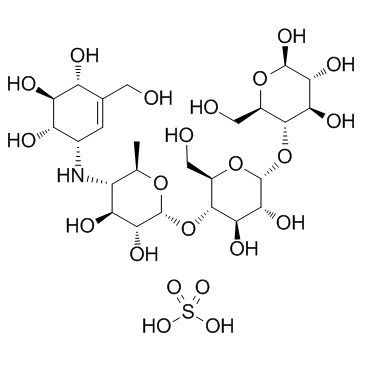Acarbose sulfate
Modify Date: 2025-08-23 00:42:45

Acarbose sulfate structure
|
Common Name | Acarbose sulfate | ||
|---|---|---|---|---|
| CAS Number | 1221158-13-9 | Molecular Weight | 743.68 | |
| Density | N/A | Boiling Point | N/A | |
| Molecular Formula | C25H45NO22S | Melting Point | N/A | |
| MSDS | N/A | Flash Point | N/A | |
Use of Acarbose sulfateAcarbose sulfate is an inhibitor of alpha glucosidase, an anti-diabetic drug. |
| Name | Acarbose sulfate |
|---|---|
| Synonym | More Synonyms |
| Description | Acarbose sulfate is an inhibitor of alpha glucosidase, an anti-diabetic drug. |
|---|---|
| Related Catalog | |
| In Vitro | Acarbose (1, 2, and 3 μM) dose- and time-dependently inhibits TNF-α-induced VSMC proliferation and migration. Acarbose (1, 2, and 3 μM) dose-dependently decreases β-galactosidase, Ras expression and increased p-AMPK expression in TNF-α pre-treated A7r5 cells[2]. |
| In Vivo | Acarbose (300 mg/60 kg body weight) decreases the fasting blood glucose, and regulates the glucose tolerance of DM rats without body weight loss. Acarbose significantly suppresses serum IL6 and TNF-α in DM rats[1]. Acarbose (2.5 and 5.0 mg/kg) significantly and dose-dependently decreases the intensity of neointimal IL-6, TNF-α, and iNOS staining, and significantly increases the intensity of neointimal p-AMPK staining. Acarbose (2.5 and 5.0 mg/kg) significantly and dose-dependently decreases neointimal Ras and β-galactosidase expression in HCD-fed rabbits without body weight loss[2]. |
| Cell Assay | Cell viability is determined using the MTT assay. Cells are seeded in 24-well culture plates at a density of 2×104 cells/well, incubated for 48 h, treated with acarbose at varying concentrations (0.5, 1.0, 2.0, 3.0, and 5.0 μM) for 24 h; or pre-treated with TNF-α (20 ng/mL) for either 24 h or 48 h to evaluate the dose-dependent effects of acarbose on VSMC growth and viability, cultured with 0.5 mg/mL MTT at 37°C in a humidified atmosphere of 5% CO2 for another 4 h, and solubilized with isopropanol. The viable cell number varies directly with the concentration of formazan product measured spectrophotometrically at 563 nm. |
| Animal Admin | Twenty-four male New Zealand white rabbits, weighing 2500 g are used. They are individually housed in metal cages in an air-conditioned room (22 ± 2°C, 55 ± 5% humidity), under a 12 h light/12 h dark cycle with free access to food and water. All rabbits are randomLy assigned to four groups of 6 animals each and are fed either standard chow (Group I), high cholesterol diet (HCD; containing 95.7% standard Purina chow + 3% lard oil + 0.5% cholesterol) (Group II), HCD diet and 2.5 mg/kg per day acarbose (Group III), or HCD diet and 5.0 mg/kg per day acarbose (Group IV). At the end of the 25 weeks, all rabbits are sacrificed by exsanguination under deep anesthesia with pentobarbital (30 mg/kg i.v.) injected via the marginal ear vein. Serum is stored at −80°C prior to measurement of serum values. The aortic arch and thoracic aortas are carefully removed to protect the endothelial lining, and are collected and freed of adhering soft tissue. |
| References |
| Molecular Formula | C25H45NO22S |
|---|---|
| Molecular Weight | 743.68 |
| Storage condition | 2-8℃ |
| Acarbose (sulfate) |